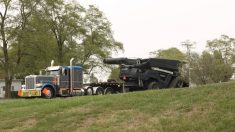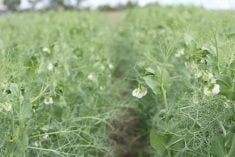Sheep producers know that feeding ewes properly is vital to flock production.
To do this, it helps to understand the ewes’ requirements, both in quantity and timing. Their needs are based on body condition, but it varies with ewe size and what they are carrying – singles, twins or triplets.
Ewes selected for breeding should be able to maintain body condition and produce offspring in the production system. This point was driven home during a recent visit to Scotland.
The sheep I saw on the heather-covered Scottish highlands were small and able to grow a lamb out before winter set in. They subsisted, and even seemed to thrive, on pitiful forage, but they could do it because they were selected for that environment.
Read Also

Fendt takes a combine on the road in the U.S.
Putting an Ideal combine in fields across different regions has given the brand a chance to prove that the combine is capable of performing well in a variety of conditions.
In Canadian production systems, producers want at least one lamb from a ewe every year. Ewes are selected for size and fertility. Instead of matching the ewe to the production system, the production system is modified to provide the nutrition that matches the ewes.
However, selection can still play an important role in health. Pregnancy toxemia occurs in ewes when nutrition fails to meet their demands. However, we now believe that “preg tox” is thought to follow family lines, just like familial diabetes in people.
This means ewe lambs produced from dams affected with preg tox should not be used for breeding, which can help select ewes that do not develop this disease.
Feed costs account for about 50 percent of production costs. To minimize this input, producers time production so that the needs of the ewes are matched with forage availability. The increased needs of late gestation and early lactation are best met with the onset of quality spring pasture. This is less expensive to deliver to the ewes than producer-supplied forage and it works well for spring lambing.
Having ewes in good shape for late pregnancy and lactation is a challenge for producers, especially in ewes carrying or nursing multiple lambs. However, the key is to get them in shape well in advance.
At breeding, body condition should increase from a maintenance level of two to 2.5 up to three to 3.5. Producers do this by boosting nutrition for four weeks, beginning two weeks before the ram goes in. Depending on the feed, it may mean adding silage or one-half to one pound of grain a day.
This flushing raises ovulation rates and boosts the lamb crop by 10 to 20 percent. Positive effects of flushing diminish if ewes are obese or extremely thin at breeding time. Flushing for more than four weeks is not justified economically.
In early gestation, body condition should stay at 2.5 to three. Nutritional requirements are just above maintenance, so the ration can be totally forage unless hay quality is poor or grain prices are so low to warrant supplementation.
If ewes are grazing crop residue, it can be supplemented with one to two pounds of alfalfa a day. Any loss of condition must be avoided.
In late gestation, nutrition must increase to push ewes into an optimal body condition of three to four for lambing and satisfy the growth of the fetal tissues. Forage must be high quality because rumen capacity and fetus compete for abdominal space, which is a problem unique to small ruminants. Poor quality forage limits intake and ewes end up being underfed.
This late gestational feeding should start about four weeks before the earliest expected lambing date and continue until the lambs are born. As long as the breeding season is limited to a four week period, the concentrate feeding period will be short. If breeding time is extended, this feeding period may be too long and ewes may become obese.
Lactation requirements are high, exceeding maintenance levels by 200 to 300 percent. If ewes are fed in confinement, this period accounts for 40 percent of the annual ewe cost. Many producers feed free-choice legume hay as well as two to three lb. of concentrate, or a similar level of silage and concentrate.
Access to pasture can negate the need for a concentrate, but even with good nutrition, ewe body condition usually drops from three to four at lambing to two to 2.5 at weaning.
At weaning, feed and water are removed from the ewes for 24 hours. Don’t take water away if the weather is hot. Once weaned, ewes should go on a poor-quality roughage, either supplied or on pasture. At this point in the production cycle, dry ewes can be used to harvest the poorer quality feed on the farm.
Jeff Grognet practices veterinary medicine in Qualicum Beach, B.C.














